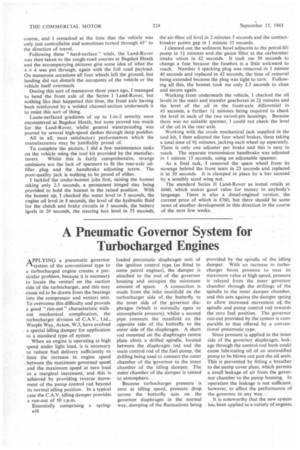A Pneumatic Governor System for Turbocharged Engines
Page 72

If you've noticed an error in this article please click here to report it so we can fix it.
APPLYING a pneumatic governor -"-system of the conventional type to a turbocharged engine creates a particular problem, because it is necessary to locate the venturt on the suction side of the turbocharger, and this may cause oil to be drawn from the bearings into the compressor and venturi unit. To overcome this difficulty and provide a good " run-out " characteristic without mechanical complication, the turbocharger division of C.A.V., Ltd., WarpIe Way, Acton, W.3, have evolved a special idling damper for application to a standard type of system.
When an engine is operating at high speed under light load, it is necessary to reduce fuel delivery sufficiently to limit the increase in engine speed between the maximum governed speed and the. maximum. Speed at zero load tO a marginal increment, and this: is achieved by providing reverse • movement of the pump control rod beyond its normal idling position. In a typical case the C.A.V. idling damper provides a run-out of 50 r.p.m.
Essentially comprising a spring loaded pneumatic diaphragm unit of the ignition control type (as fitted to some petrol engines), the damper is attached to the end of the governor housing and occupies the _minimum amount of space. A connection is made from the inlet manifold on the turbocharger side of the butterfly to the inner side of the governor diaphragm (which is normally open to atmospheric pressure), whilst a second pipe_ connects the manifold on the opposite side of the butterfly to the outer side of the diaphragm. A short rod mounted on the diaphragm centre plate abuts a drilled spindle, located between the diaphragm rod and the main control rod of the fuel pump, the drilling being used to connect the outer chamber of the governor NI the inner chamber of the: idling _damper. The outer chamber of the damper is vented :toiatrriosPhere. '
Because turbocharger pressure is zero at idling speed, pressure drop across the • butterfly acts on . the governor diaphragm in the normal way, damping of the fluctuations being provided by the spindle of the idling damper. With an increase in turbocharger boost pressure to near its maximum value at high speed, pressure is relayed from the inner governor chamber through the drillings of the spindle to the inner damper chamber, and this acts against the damper spring to allow increased movement of the spindle and pump control rod towards the zero fuel position. The governor run-out provided by the system is comparable to that offered by a conventional pneumatic type.
Since pressure is applied to the inner side of the governor diaphragm, leakage through the control-rod bush could cause lubricating oil of an unmodified pump to be blown out past the oil seals. This is prevented by fitting a breather to the pump cover plate, which permits a small leakage of air from the governor chamber to the pump housing. In operation the leakage is not sufficient. however, to affect the performance of the governor in any way..
It is noteworthy that the new system has been applied. to a variety of engines.




































































































































